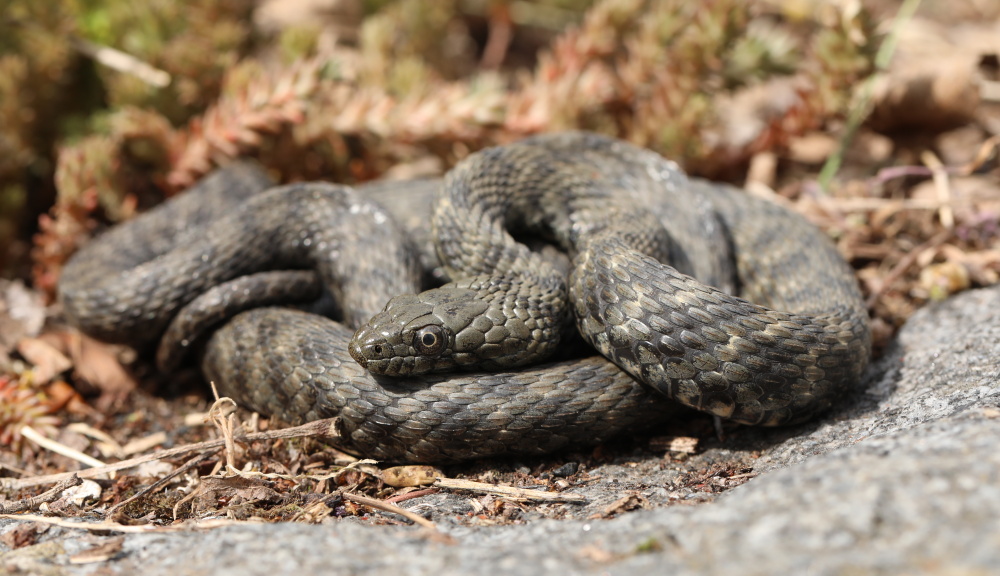Prague Zoo presents Czech snakes. There is no need to be scared of them

Prague Zoo is now displaying four species of snakes commonly found in the Czech Republic in its Terrarium: the grass snake, the dice snake, the smooth snake and the common European viper. This exhibition aims to show the differences between our snakes and to remind us that there is nothing to be afraid of.
 Common European viper. Photo: Václav Šilha, Prague Zoo
Common European viper. Photo: Václav Šilha, Prague Zoo
"Our curator of reptiles, Petr Velenský, began preparing this exhibition last summer, when the media were awash with exaggerated reports about an alleged viper invasion of a North Bohemian cemetery. Similar reports appear every year and cause panic for no reason at all,” said Miroslav Bobek, director of Prague Zoo. “All of our snake species are endangered and in decline, so thoroughly deserve protection.”
The smooth snake and other species often pay a high price for their similarity to the common European viper.
"Only the common European viper is venomous, the others are non-venomous snakes. It may not be easy for a layperson to distinguish between a viper and a grass snake, because snakes are very variable in both colour and size, and the snake you observe does not always correspond to a photograph from the Internet,” added Petr Velenský. “Even a bite from a viper is not life-threatening for a healthy person, but it is necessary to remain calm and seek medical attention.”
Moreover, if you are not sure which snake you have met in the wild, send a photo of it to: kontakt@zoopraha.cz. Our keepers will determine what species it is for you.
The ten most common misconceptions about vipers
“Vipers are overpopulating”
The common European viper is listed as a critically endangered species by Ministry of the Environment Decree No. 395/1992 Coll. It may be locally abundant in the foothills or the mountains, but, in general, it is a rare snake. It is usually completely absent in lowland and warm areas. Vipers mostly “overpopulate” in the media during the “silly season”.
“Vipers attack”
The viper is a timid snake that always prefers to avoid humans rather than face a confrontation. The viper will only bite in self-defence, most often in fright. A bite occurs when a human reaches out with an unprotected hand or steps on a viper with an inadequately protected foot. The strike range of a viper that has been caught outside of its shelter and feels threatened is no more than half a metre. If you encounter a viper on a mountain path, you can walk around it quite safely, or you can calmly take a photo of it from a distance of about a metre.
“Conservationists release vipers”
We often come across this dangerous rumour at the zoo or on internet discussions. It does great injustice to our colleagues working in nature conservation. One bizarre offshoot is the version about releasing vipers from helicopters. No vipers have ever been released into our countryside! The introduction or reintroduction of any animal into the wild is very complex and subject to strict rules. No animal can be released into the wild without government approval. Moreover, the viper is a species that is difficult to keep in captivity. It is, to all intents and purposes, impossible to breed them in such numbers that they can be introduced into the wild.
“The viper is a large snake”
All reports of one to two metre vipers automatically get put into the rumour category. The viper is a small snake. The vast majority of females measure 50-70 cm, with males at the lower end of that range. A viper longer than 75 cm is quite rare. Sightings of vipers around one metre in recent years are undocumented in this country.
“A snake without a collar behind its head is a viper"
There are five species of snakes living in the Czech Republic. Of these, only the commonly known grass snake has a “collar” behind its head. The smooth snake, which is scattered throughout the Czech Republic, is most often confused with the viper. In warm areas around rivers, the dice snake is often called a water viper by locals. Some people even panic unnecessarily after having mistaken a slow worm for a viper.
“Vipers kill dozens of people every year”
A scientific study summarizing 15 years of treating viper bites in our country (J. Valenta, Z. Common Viper Bites in the Czech Republic - Epidemiological and Clinical Aspects during a 15 Year Period (1999-2013). Prague Medical Report / Vol. 115 (2014) No. 3-4, p. 120-127) does not report any deaths from viper bites, and no cases were recorded in the following seven years (Valenta, personal communication). In the last 50 years, there is just one documented case of death following a viper bite. The man was ill and had handled the viper with his bare hands before being bitten. The cause of death was probably anaphylactic shock.
“Most viper bites result in death”
A viper bite is a health complication that should not be underestimated and medical attention should be sought. However, there is no need to fear for your life. Viper venom has a gradual onset, haste and hysteria are not called for. The doctor will then most likely monitor the health of the affected person and intervene in the event of complications. From 1999 to 2020, specialists at the VFN Toxinology Centre were consulted on 352 cases nationwide without a single death. Moreover, over a quarter were so-called “dry” bites with no injection of venom. Only a quarter of the treated cases showed more than local symptoms of poisoning.
“Bite wounds need to be cut, sucked, tied”
No, no, no. Keep calm, seek medical attention. Move the affected limb as little as possible (arm in a sling, leg in a splint). Do not drink coffee or alcohol. Any unprofessional handling of the wound may worsen any possible consequences.
“It is dangerous to enter places where vipers occur”
In the mountains, in places where vipers are traditionally found, people are usually not afraid. They know that good footwear and basic caution are enough to prevent an accident. Once again, a bite occurs when a person touches a viper with an unprotected hand or steps on it with an inadequately protected foot. The aforementioned statistics, from 1999 on, show that such accidents are actually very rare in our country. There are 16 bites per year, on average, with a high of 37 cases in one year. This statistic proves that the Czech Republic (including areas with high viper numbers) is a very safe place in this respect.
“Vipers don’t belong here”
Snakes are a very important part of natural food chains. The dominant food of adult vipers is rodents, especially voles. The viper therefore acts as their regulator. However, the natural importance of animals is no longer gauged by their “usefulness” to humans. The importance of a species in the complex web of natural relationships cannot be encompassed by this perspective. The common European viper is a fascinating element of our beautiful countryside that poses a negligible risk to the public.
An overview of Czech snakes that you can often meet in the countryside:
Common European viper
It is a small but robust snake that usually reaches 50 cm in length, but can, on rare occasions, be longer than 70 cm. It is found in the mountains and uplands; it is absent in the warm lowlands. It is our only snake that has a darker continuous stripe along its spine with crossbars to the sides, the so-called “zigzag line”. Occasionally, especially in the mountains, vipers may be entirely black. Its bite is not life-threatening for a healthy person; keep calm and seek medical attention.

Smooth snake
It is small and slender, usually between 50 and 70 cm in size. Of all our grass snakes it is most often mistaken for a viper. It occurs in a patchwork pattern throughout the country. It usually has a series of spots of varying sizes along its back that do not join into a continuous zigzag band. It has a crown-shaped pattern on and behind its head. It is covered with metallic, shiny scales (vipers have a more velvety sheen).

Grass snake
It is a small to medium snake up to a maximum size of 110 centimetres. It is the most common Czech snake and can be found throughout the country. It has two yellow or whitish spots in the shape of a collar behind its head, otherwise its body has no distinctive spots. The head is a regular oval shape.

Dice snake
Male dice snakes are small and slender (50-70 cm), while the females are larger and robust (70-110 cm). They occur in the warmest areas of the Czech Republic, mostly near rivers. The dice snake is rarely encountered, but is, nevertheless, nicknamed the “water viper” by people living around the Berounka, Sázava or middle Vltava rivers. It has more or less distinctive spots, distinctively keeled scales and a triangular head, its eyes pointing forward.
Aesculapian snake
It is the largest Czech snake - it has a long and muscular body (regularly over 100 cm, in Slovakia up to 200 cm). It is rarely mistaken for a viper and is rare, living locally in three limited areas of the country where it is well known to the locals. Adult Aesculapian snakes have a uniform pastel brown body, whereas juveniles have a faint yellow “collar” behind the head. They have a long oval head. This species is the only one not currently on display in Prague Zoo’s exhibition of Czech snakes.

ZOOPRAHA.CZ
Contacts
- The Prague zoological garden
U Trojskeho zamku 120/3
171 00 Praha 7
Phone.: (+420) 296 112 230 (public relations department)
e-mail: zoopraha@zoopraha.cz
Others









